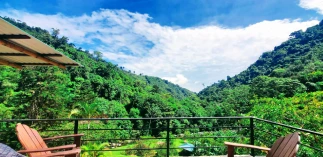Here at our Costa Rican mountain retreat, mornings erupt in a symphony of birdsong. From the melodic calls of the toucan to the vibrant whistles of the oropendola, the soundtrack of the rainforest is a constant source of wonder. Today, we turn our focus to a delightful resident, the aptly named Banded Wren.
A Flash of Black and White
The Banded Wren is a true charmer, a tiny ball of energy with a plumage that lives up to its name. Its most striking feature is the bold contrast between its black and white markings. A crisp white eyebrow streaks across its dark brown head, while its underparts are a canvas of white broken by thick black bars on its sides and flanks. This striking pattern makes it instantly recognizable as it flits through the undergrowth.
A Forest Floor Forager
Unlike some of its wren brethren that prefer the higher branches, the Banded Wren is a creature of the forest floor. Here, it busily hops and flits, its short tail cocked upwards as it searches for its next meal. Its diet consists primarily of insects, spiders, and other invertebrates, making it a valuable pest controller in the rainforest ecosystem.
A Songster of the Thicket
While the Banded Wren may not be the most flamboyant in its appearance, it more than makes up for it with its vocal talents. Its song is a vibrant mix of clear whistles and musical trills, often delivered in rapid succession. You might also hear its shorter calls, a nasal “cherrrt” or a rhythmic “kert rrruk kert rrruk.” These vocalizations help the wrens stay in contact with each other and defend their territory.
Home is Where the Thorns Are
The Banded Wren is a resident breeder in Costa Rica, found primarily on the Pacific side of the central mountain ranges, including lowlands and foothills up to 800 meters. Its preferred habitat is a mix of open or scrubby woodlands, including thorn forests, thickets, plantations, and even forest clearings. Interestingly, it seems to favor areas with a fairly open understory, allowing it to flit and forage with ease.
A Nest Fit for Royalty (or Royalty-Sized Insects)
The Banded Wren’s nest is a fascinating creation. Shaped like a flask with a long entrance tube angled downwards, it’s often constructed with fine grasses and tucked away in the fork of a thorny tree or shrub, sometimes even near a wasp nest for added protection. The female wren takes sole responsibility for incubating the clutch of 3-5 unmarked or lightly brown-spotted white eggs, while both parents work together to raise the chicks after hatching.
A Birder’s Delight
The Banded Wren, with its charming looks and captivating song, is a delightful addition to the Costa Rican avifauna. While it may not be the easiest wren to spot, with a little patience and a keen ear, you might just catch a glimpse of this captivating songster flitting through the undergrowth on your next visit to our mountain retreat.
Keep an eye out for our next blog post, where we will explore another feathered friend from the vibrant tapestry of Costa Rican birds!
For more information, please view our comprehensive guide about the birds of Costa Rica







